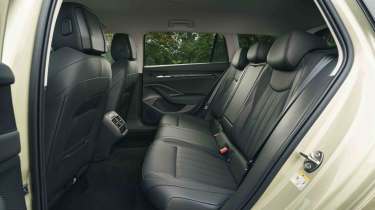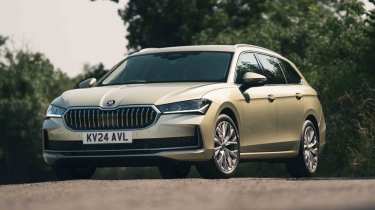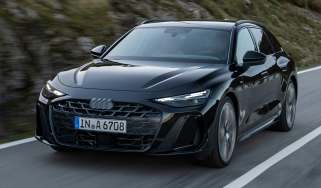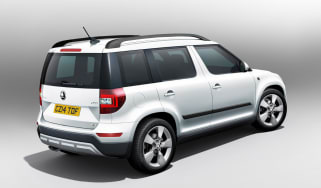Skoda Superb Estate review – a near-faultless, practical family car
“The latest Skoda Superb Estate builds on its predecessor’s impressive practicality and value with improved build quality and interior flair”
Pros
- Comfortable
- Even more practical than before
- Great quality interior
Cons
- No electric model
- Unengaging
Verdict – is the Skoda Superb Estate a good car?
The Skoda Superb has long been a Carbuyer favourite, delivering on value for money and practicality, just as a Skoda should. This latest Estate model brings an even bigger boot, and interior quality is also better than before, so it strikes a great balance between usability and modern design. Some of the engine options look a bit dated on paper, but they’ve been thoroughly improved to be even more efficient and responsive. There may be better cars to drive, but the Superb Estate is comfortable and capable enough where it counts.
Skoda Superb Estate models, specs and alternatives
We love the Skoda Superb even in standard form because it’s incredibly practical and good value for money – if you need even more practicality, though, there’s the Skoda Superb Estate. The Superb Estate might just be the answer if you need the extra space but also don’t want to follow the crowd with an SUV – adding to the appeal is that it gets the same interior as the rest of the Superb range, which has taken a huge stride forward in quality, fit and finish compared to the previous generation.
While Skoda models have historically been positioned as the budget-friendly versions of Volkswagen models using outdated tech and underpinnings to keep costs down, that’s no longer the case – the fourth-generation Superb Estate was designed alongside the latest Volkswagen Passat (which is now estate-only). Volkswagen may have shot itself in the foot here though, because the Superb Estate is the better car, and we appreciate all of its extra ‘Simply Clever’ features that make it easier to get on with.
This time around, despite having a completely new body compared to the old Superb, Skoda hasn’t strayed too far from its existing range in terms of styling. It’s immediately recognisable as the successor to the outgoing car, although if you take a closer look there’s a slightly larger octagonal-shaped grille, thinner headlights and it’s got a slightly softer, simpler look compared to before.
More reviews
The Skoda Superb Estate has grown, though – it’s 40mm longer than the old car and that’s translated to a larger boot to keep it on top in one area that matters most to Skoda buyers: practicality.
Skoda has been more daring on the inside, though, and the latest Skoda Superb Estate, along with its hatchback sibling, gets a thoroughly overhauled interior with a more en-vogue minimalist, and high-quality look. We’re happy to report that Skoda hasn’t completely abandoned physical controls, however, and the brand has dotted around some very intuitive solutions to keep the interior user-friendly and yet uncluttered.
The latest Skoda Superb Estate is offered with a range of engines, including three petrols, two diesels and a plug-in hybrid, so buyers are well catered for. An electric version isn’t expected to join the range, at least for this generation. The Superb is now offered solely with an automatic gearbox.
The Superb Estate, like its hatchback sibling, is offered in SE Technology, SE L and top-spec Laurin & Klement trims, and the SportLine model joined later, bringing Sports suspension with a lowered ride height, gloss black exterior trim for a racier look and goodies such as heated sports seats among other additions.
| Trim levels | Power options |
|
|
MPG, running costs & CO2 emissions
Skoda is a brand known for its affordable cars that present good value, and in the same vein, the Skoda Superb needs to be cheap to run. As with the previous model, the Skoda Superb Estate is offered with a range of petrol and diesel models, as well as a plug-in hybrid option, which are all familiar units used in the latest Volkswagen Passat. Like in that car, most of the fuel economy figures across the range are yet to be confirmed by Skoda.
The entry-level 1.5-litre TSI e-TEC petrol engine gets mild-hybrid technology which takes some of the strain off the combustion engine to help achieve improved fuel economy. We’ve tested it in the closely related Volkswagen Passat, where it achieved an impressive figure of 51.8mpg; not far off what you might expect of a diesel. There’s also a 2.0-litre petrol version of the Skoda Superb Estate with either 201bhp or 261bhp, but while they’re more powerful, they’re much less efficient on fuel.
If you cover a lot of motorway miles or spend time towing, the Skoda Superb Estate is one of the few cars still offered with a couple of diesel options. Official figures for the 148bhp engine are in the high 50s for mpg, while opting for the more powerful 190bhp version cuts it by about 10mpg.
The plug-in hybrid TSI iV should be the cheapest to run if you can afford its list price and have the means to charge it often and make the most of its 62-mile electric range. Up against rival plug-in hybrid models, the Skoda fares well in terms of electric range – its 62-mile figure is identical to that of the Passat and trumps the BMW 330e’s 28-mile figure, though the Mercedes C300e Estate can achieve up to 65 miles of range. Official CO2 emissions figures are low, so that puts it in a low BiK (Benefit-in-Kind) tax bracket for company-car buyers.
| Model | Fuel economy | CO2 emissions |
| 1.5-litre mild-hybrid TSI e-TEC (148bhp) | 52.3mpg | 122g/km |
| 2.0-litre petrol TSI (201bhp) | 40.9mpg | 156g/km |
| 2.0-litre petrol TSI (261bhp) | 36.2mpg | 177g/km |
| 2.0-litre diesel TDI (148bhp) | 57.6mpg | 129g/km |
| 2.0-litre diesel TDI (190bhp) | 47.9mpg | 154g/km |
| 1.5-litre plug-in hybrid TSI iV (201bhp) | 706.2mpg | 8g/km |
How efficient is the Skoda Superb Estate in the real world?
Our Skoda Superb Estate test car was fitted with the 2.0-litre TDI diesel in 148bhp guise – we achieved around 55.6mpg by our own calculations, so it’s not far off the brand’s official WLTP figures.
What will the Skoda Superb Estate cost to insure?
The Skoda Superb Estate starts in group 23 out of 50 for insurance, which rises to up to group 35 if you go for the top-spec Laurin & Klement version with the most powerful 261bhp TSI engine. That means lower-spec versions are roughly on-par with the equivalent hatchback Superb, though the top-spec Estate sits one group higher. The Passat starts two groups higher, although the top-spec plug-in hybrid Passat is slightly cheaper to insure in group 34 despite a higher power figure than the most powerful Superb Estate TSI.
Engines, drive & performance
The Skoda Superb is offered with a variety of engine options, including three petrols (one of which gets mild-hybrid assistance), two diesels, and a plug-in hybrid, so there’s lots of choice for buyers. All versions of the Skoda Superb are now automatic, with all but the plug-in hybrid (that uses a six-speed DSG) sending power through a seven-speed DSG gearbox that’s been a tried-and-tested staple of parent-company Volkswagen Group’s cars for some time. The higher-performance petrol and diesel models come with four-wheel drive, while the entry-level 148bhp models are front-wheel drive.
Although there are no performance upgrades as such, the SportLine model introduced in August 2024 brings sports suspension and a ride height lowered by 15mm. We’re yet to drive it, but these additions may well improve the Superb Estate’s agility through the corners, though the larger 19-inch wheels will likely also mean ride quality suffers – we’ll reserve full judgement until we’ve tried it.
Is the Skoda Superb Estate good to drive in town?
The Skoda Superb’s steering feels well-weighted for all-round applications, without feeling spongy or overly light. Our test car’s optional adaptive dampers worked superbly to offer a smooth ride around town in Comfort mode, so if that’s a priority it’s worth springing for. There’s a high degree of configuration for this feature, but we didn’t like how fiddly these settings were to tweak.
We were impressed with how well the 148bhp 2.0-litre diesel performed around town at lower speeds, but the 1.5-litre TSI e-TEC petrol with an identical power figure, or the plug-in eHybrid that can drive on electricity alone, are both likely to prove the better choice for city driving.
Is the Skoda Superb Estate good to drive on long journeys?
The Skoda Superb Estate is well suited to long journeys and motorway cruising. Its supple and refined ride comes into its own in these scenarios, and it’s only improved by the impressive lack of road and wind noise in the cabin. The only problem is that, while diesels are better suited to motorway driving, the version we tested produced a fair bit of engine noise when under strain, although this is less of a problem at cruising speeds.
Is the Skoda Superb Estate good to drive on B-roads?
Quite frankly, the Skoda Superb isn’t really designed for sprightly driving around B-roads, although there are a few driving modes which make it more adaptable than you might expect. While keeping the car in Comfort does leave it feeling a bit wallowy and unpredictable, Sport mode does a good job of tightening things up to tackle corners in a more composed manner.
Diesel models
While the latest Skoda Superb Estate may look more modern in terms of its exterior, there’s nothing particularly groundbreaking about its diesel engines. Our test car was fitted with the lower-powered of the two 2.0-litre diesels with 148bhp, and it felt very familiar.
It’s not particularly refined at lower speeds, with a fair bit of engine noise transmitted into the passenger compartment. Aside from that, there have been some slight improvements, and the 148bhp TDI now feels more responsive and easier to drive than that of the equivalent outgoing model, especially in low-speed scenarios.
As a result, we suspect this version will suit most buyers, but there’s always the higher-powered diesel for a little more oomph if you want it.
| Model | Power | 0-62mph | Top speed |
| 2.0-litre TDI | 148bhp | 9.3 seconds | 139mph |
| 2.0-litre TDI | 190bhp | 7.6 seconds | 147mph |
Petrol models
Even the entry-level petrol Skoda Superb gets some electrification, by way of a mild-hybrid system that takes some of the strain off its 1.5-litre petrol engine, and helps boost power up to a healthy 148bhp. We’ve yet to drive it in the Superb Estate, but its application in the Volkswagen Passat proved it to be well-suited to such a large car, despite its small size. Above this, there’s a 2.0-litre petrol TSI engine with either 201bhp or 261bhp, though we expect most buyers to go for the more modest power options.
| Model | Power | 0-62mph | Top speed |
| 1.5-litre TSI e-TEC mild-hybrid | 148bhp | 9.3 seconds | 139mph |
| 2.0-litre TSI | 201bhp | 7.4 seconds | 144mph |
| 2.0-litre TSI | 261bhp | 5.7 seconds | 155mph |
Plug-in hybrid models
The plug-in eHybrid version of the Skoda Superb Estate uses the same 1.5-litre engine, but mated with an electric motor for a combined 201bhp. This version can also manage an impressive 62 miles of electric driving to a charge, so you can waft around silently for longer than most – but not all – rivals. We’re yet to drive the eHybrid, but we’d expect it to be more refined than the diesel for the most part, thanks to the lack of engine noise when running on an electric motor alone.
| Model | Power | 0-62mph | Top speed |
| 1.5-litre eHybrid PHEV | 201bhp | 8.1 seconds | 136mph |
Electric models
There’s no fully-electric version of the Skoda Superb Estate, nor is there expected to be one for the hatchback. For now, if you’re looking for an electric Skoda, you’re catered for by the Skoda Enyaq and Enyaq Coupe SUVs, or you could jump into the all-electric Volkswagen ID.7 Tourer.
Interior & comfort
The latest Skoda Superb gets a much more mature look on the inside, with a minimalist design, and a larger, more modern infotainment system as its centrepiece. Unlike some manufacturers who do away with switches and knobs in favour of frustrating virtual or touch-sensitive controls, Skoda has struck a good balance with some interesting solutions that combine the best of physical and virtual controls.
Materials are of a higher quality than before, with stitched leather, soft-touch plastics and high-quality fabrics, but some of the dials feel a little cheap to the touch – a minor gripe. So much thought has gone into the Skoda’s interior design, and there are even neat touches such as a cleaning block in the glovebox with a cleaning spray to keep the infotainment screen and shiny surfaces fingerprint-free.
Is the Skoda Superb Estate’s infotainment and navigation system easy to use?
The Skoda Superb Estate gets a new 13-inch infotainment screen that sits atop the dashboard, rather than within it, like in the old model, making it easier to glance at without taking your eyes off the road. The system is intuitive, logically laid out and responsive, and takes care of most of the sat nav and media functionality, but we’re pleased that Skoda hasn’t removed physical controls completely in an obsessive pursuit of minimalism.
One real plus point for the Skoda Superb’s interior is the introduction of the brand’s Smart Dials. This is a set of three rotating controls which can be configured to adjust a range of different functions, such as the climate control, media volume or even drive modes, which can be toggled by pressing the face of each unit. This is a fantastic solution which helps keep the interior uncluttered while still providing useful feedback so they can be used easily and safely on the move.
Is the Skoda Superb Estate well equipped?
The Skoda Superb and its Estate variant comes in a choice of three trims from launch. Entry-level SE Technology is well equipped, though, with tri-zone air conditioning, digital dials and useful tech such as Android Auto and Apple CarPlay and sat nav as standard. It’s clear from the specs sheet alone that the Skoda Superb is far from feeling like a budget-focused model. The SportLine model was introduced in August 2024 for those buyers that want a slightly racier look, complete with gloss black exterior trim and larger 19-inch alloy wheels, as well as heated sports seats and other additions.
Key features | |
|
SE Technology
|
SE L (SE Technology plus…)
|
|
Laurin & Klement (SE L plus…)
|
SportLine
|
Practicality & boot space
The Skoda Superb Estate has grown in length by around 40mm compared with the previous model, but because it’s lower and sleeker than before in the pursuit of aerodynamic efficiency, the interior doesn’t feel as spacious as it could. Still, we’re splitting hairs because the Superb Estate is still very roomy inside indeed.
| Size comparison | |||
| Model | Length | Width | Height |
| Skoda Superb Estate | 4,902mm | 1,849mm | 1,482mm |
| Volkswagen Passat | 4,917mm | 1,852mm | 1,506mm |
| Audi A6 Avant | 4,939mm | 1,446mm | 1,481mm |
| Peugeot 508 SW | 4,778mm | 1,859mm | 1,420mm |
Does the Skoda Superb Estate have a big boot?
The Skoda Superb Estate’s boot has increased in size by 30 litres for a total capacity of 690 litres overall. This is identical to the boot capacity of the Volkswagen Passat, alongside which the Superb Estate was developed. Fold the seats down and there’s a cavernous 1,920 litres of cargo space, so the Superb Estate should prove to be very practical if you need to transport large items.
As is expected of a Skoda, there are lots of useful storage solutions dotted around the cabin including a large box in the centre armrest. There are also some clever features in the boot, such as flaps that fold up from the floor to secure boxes and stop them sliding around.
| Boot space comparison | |
| Model | Boot space |
| Skoda Superb Estate | 690 litres |
| Volkswagen Passat | 690 litres |
| Audi A6 Avant | 565 litres |
| Peugeot 508 SW | 530 litres |
Is the Skoda Superb Estate a good tow car?
If you need to tow with the Skoda Superb Estate, the 1.5-litre mild-hybrid petrol can haul up to 1,900kg, but your best bet is one of the diesels, both of which have a towing capacity of up to 2,200kg.
Reliability & safety
Skoda tends to perform better as a brand in our Driver Power customer satisfaction surveys compared to its sister brands from the Volkswagen Group. That said, most of these have been on a downward trajectory with regards to customer satisfaction in recent years. Skoda came in 23rd place out of 32 manufacturers in 2024, which is ahead of Volkswagen (29th), Audi (27th) and SEAT (24th) but behind Cupra in 18th place. Reliability seems about average, with 24% of Skoda buyers reporting an issue in the first year of ownership.
How safe is the Skoda Superb Estate?
The Skoda Superb Estate is yet to be tested by Euro NCAP, but we’d expect it to perform well thanks to its high amount of safety equipment as standard. All cars get a comprehensive suite of technology such as autonomous emergency braking technology, a driver fatigue sensing system and forward collision warning.
What are the Skoda Superb Estate’s service intervals?
Skoda recommends getting its cars serviced every 12 months or 10,000 miles, whichever comes first. The brand offers 0% interest plans to help spread the cost, starting from £220 to cover your servicing for up to three years of 30,000 miles.
What is the warranty on the Skoda Superb Estate?
Skoda offers a three-year warranty on its cars as standard. In the first two years this is valid regardless of mileage, while the third year is capped at 60,000 miles. It’s a shame this warranty isn’t more competitive, because as it stands it’s just on par with the industry standard.
Should you buy a Skoda Superb Estate?
We’ve been big fans of the Skoda Superb and its Estate variant in the past, with the previous model offering impressive value for money and an impressive amount of space and practicality. This time around there’s more of the same, but that’s no bad thing.
Skoda has improved in key areas such as build quality and even added a little more flair to the interior, which feels more upmarket as a result. We appreciate Skoda’s efforts to keep some physical controls in a market that can seem overly obsessed with making everything touchscreen-based.
The entry-level Superb’s 1.5-litre mild-hybrid engine is a first for the model, offering diesel-like fuel economy and it should be easily capable enough for most buyers. The diesel engines don’t differ too much from what was offered previously, with Skoda sticking to what it knows, although even better fuel economy and responsiveness represent small improvements to improve on the formula.
Quite simply, the Skoda Superb Estate has few compromises when it comes to offering an impressively compelling all-round package. There’s very little to complain about, so the Superb Estate is an easy car to recommend.
What is the best Skoda Superb Estate for low running costs?
If your budget stretches to the plug-in eHybrid model, and you have the means to regularly keep it charged, it should prove the most economical, with an impressive 62-mile electric range covering off most commutes. Its low CO2 emissions also put it into a low BiK band, so it will be a good choice for company-car buyers.
What is the Carbuyer pick of the Skoda Superb Estate range?
We’d stick to the entry-level SE Technology trim as it offers the best value for money, being well-equipped as standard. Our experience of the entry-level 1.5-litre TSI e-TEC mild-hybrid in the Volkswagen Passat was very positive and it felt well suited to most buyers, so we expect this engine to be just as good in the Superb Estate.
Skoda Superb Estate alternatives
While many manufacturers have ditched traditional family estate cars in favour of SUVs, Skoda still offers the Superb Estate in this dwindling class and it’s been developed closely alongside the Volkswagen Passat, which is now estate-only. As always, Skoda aims to offer the Superb at prices from the class below, while offering practicality that gives all-comers a headache.
Large estate cars
There are a few large estate cars still on the market, though there’s considerably less choice than there would have been a few decades ago. The Superb Estate definitely errs more on the side of practicality, rather than premium feel, but it’s still a little more upmarket than before.
- Volkswagen Passat
- Peugeot 508 SW
- BMW 5 Series Touring
- Mercedes E-Class Estate
- Audi A6 Avant
- Jaguar XF Sportbrake
How we tested the Skoda Superb Estate
We first tested the Skoda Superb Estate with the 148bhp 2.0-litre TDI diesel engine on European roads in March 2024.
Which Is Best?
Cheapest
- Name1.5 TSI e-TEC SE Technology 5dr DSG
- Gearbox typeSemi-auto
- RRP£36,995
Most Economical
- Name1.5 TSI iV SE Technology DSG 5dr
- Gearbox typeSemi-auto
- RRP£41,465
Fastest
- Name2.0 TSI Sportline 4X4 5dr DSG
- Gearbox typeSemi-auto
- RRP£47,995

















































